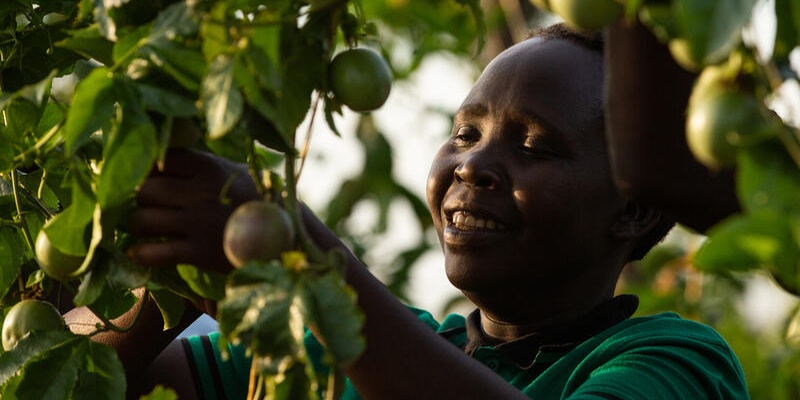SPOTLIGHT: As its economy grows, Uganda prepares to increase exports of fresh plant produce
Posted on Tue, 22 Apr 2025, 08:21

A passion fruit farmer in Uganda © FAO / Vincent Tremeau
Cut flowers, live trees, avocados, bananas, and green chilies. In the last 20 years, Uganda’s exports, which are dominated by plants and plant products, have increased sixfold to more than USD 6 billion a year. Driven by demand and government reform, local officials are looking to further enhance agricultural trade as a way to grow the East African nation’s economy and reduce poverty rates.
Uganda’s goods mostly end up in Europe, but they also make their way to neighboring South Sudan, Kuwait, and countries as distant as Thailand and South Korea. Because the governments of these countries recognize Uganda’s commitment to upholding strong export safeguards and operating near the top of its capacity, concerns about pests and diseases potentially contained in incoming consignments have been limited.
That’s because Uganda is working hard to improve its phytosanitary system, which follows international standards when it comes to export certification. As a signatory to the International Plant Protection Convention (IPPC), Uganda is positioning itself as a major trading partner for countries with an appetite for tropical produce.
“Uganda has enormous potential for trade of plants and plant products because of its position on the equator, abundant resources, diverse crop commodities, growing trade infrastructure, organic agriculture and investment opportunities in commercial agriculture, value addition and agro-processing,” says Musimenta Herbert, Principal Agricultural Inspector at Uganda’s Ministry of Agriculture, Animal Industry and Fisheries.
To further improve its export potential and import verification capacity, Uganda is developing new strategies and partnerships. In 2024, for example, the country undertook a phytosanitary capacity evaluation (PCE). Guided by standards developed by the IPPC Secretariat, local authorities worked to improve skills in pest diagnostics, surveillance, eradication, and export certification. To facilitate the process, stakeholders participated in deep dive sessions where they looked at areas that required improvements in their quarantine system.
Uganda’s PCE was conducted as part of a broad USD 7 million project funded by the European Union (EU), which was designed to strengthen both food safety and plant import and export systems for 11 countries within the Common Market for Eastern and Southern Africa (COMESA) region. The project was designed to assist countries identify gaps, implement improvements, and ultimately support safe international trade.
“Plant pests represent a major challenge to agricultural productivity, food security, environmental sustainability, and trade efficiency within the COMESA region,” says an IPPC assessment of the PCES in Africa. “These pests cause annual crop losses ranging from 30 percent to 60 percent, resulting in an estimated economic impact of approximately USD 65.5 billion. Tackling these risks is critical to ensuring economic stability, protecting livelihoods, and strengthening food security, particularly in the region’s most vulnerable nations.”
Like Uganda, most countries that took part in the PCEs prioritized evaluation modules related to core operational activities, such as diagnostics, surveillance, and risk analysis, reflecting a desire to strengthen their technical capacity in these areas. However, modules covering governance, such as stakeholder engagement and environmental factors affecting operations, were among the least selected by participating countries, highlighting a gap in long-term strategic planning and policy coordination.
To complete the Ugandan PCE, a certified PCE facilitator helped guide local officials through the deep dive sessions. As well as making presentations on the IPPC standards, the facilitator helped conduct lengthy interviews with quarantine officers and other government officials. A situational analysis was prepared, and interviews were conducted with representatives from export industries.
In a significant step forward, Uganda has now secured EUR 8 million from the EU to implement the lessons it learned from the PCE process. The Ugandan finance ministry also pledged another USD 5.5 million toward the effort, recognizing the importance of supporting the ministry responsible for plant health. The country now plans to enhance its skills when it comes to inspections, diagnostics, and surveillance. It will also improve training for staff in both the public and relevant private sectors, and develop communications for stakeholders. Logistical infrastructure will also be a focus and will target cold chains, packhouses and testing laboratories.
“They have amazing commodities to sell,” says Shaza Omar, phytosanitary specialist with the IPPC secretariat. “The PCE process helped Uganda recognize its strengths and how to utilize them. Hopefully this process will improve trade and the country will recognize the potential of its agricultural economy.”
Stakeholders to improve engagement on plant health
Omar says stakeholders worked well together during the Ugandan PCE, as most people had completed IPPC e-learning courses before the process began. “We were all on the same page and people were using the same language, which is very important.” Phytosanitary stakeholders, including government staff and private sector representatives, can access relevant courses on the new IPPC Plant Health Campus. The campus is a joint effort being implemented by the IPPC and the FAO Learning Academy, and provides high-quality training materials designed to upskill staff who work for national plant protection organizations. The latest e-learning course is titled “Engaging with stakeholders on plant health”.

